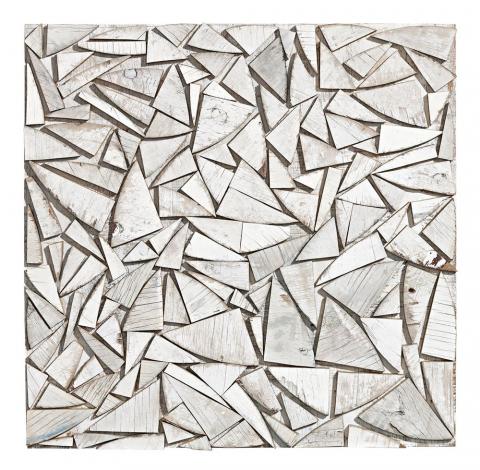KALEIDOSCOPE, 1994
ROSALIE GASCOIGNE
sawn plywood on plywood
77.5 x 78.5 cm
signed, dated and inscribed with title verso: Rosalie Gascoigne / 1994 / KALEIDOSCOPE
Roslyn Oxley9 Gallery, Sydney
Private Collection, Melbourne
Greenaway Art Gallery, Fourth Australian Contemporary Art Fair, Melbourne, 29 September – 2 October 1994
MacDonald, V., Rosalie Gascoigne. Sydney: Regaro, 1997, p. 108
‘Second hand materials aren’t deliberate; they have sun and wind on them. Simple things. From simplicity you get profundity.’1
With her training in the formal discipline of Ikebana complementing her intuitive understanding of the nature of materials, her deep attachment to her environment and later interest in modern art, Rosalie Gascoigne remains one of Australia's most revered assemblage artists. Bespeaking a staunchness and scrupulous eye, her works are artful and refined, yet always maintain a close proximity to the outside world, powerfully evoking remembered feelings or memories in relationship to the landscape; they are 'instances of emotion recollected in tranquility' to quote a phrase of Wordsworth's which was so dear to her.
Although inextricably linked in their inspiration and materials to her physical surroundings on the outskirts of Canberra, Gascoigne’s achievements nevertheless transcend the provincial to encapsulate a larger, more intangible sense of place that is, paradoxically, ‘both nowhere and everywhere at once.’2 Having eschewed the use of iconography, she favors rather allusion and suggestion to capture the timeless ‘spirit’ of the landscape so that her art ‘may speak for itself’, awakening ‘…associations that lie buried beneath the surface of consciousness; inviting a higher degree of sensitivity and attentiveness to the world around us.’3
With its faded palette of cream, white, taupe and grey, Kaleidoscope, 1994 may be construed as the culmination of a career dedicated to elimination of the unnecessary. In stark contrast to the shimmering black-on-gold Schweppes assemblages for which Gascoigne is so widely acclaimed, here even colour itself is eradicated to focus the viewer’s attention ever more emphatically upon ‘presence’: ‘You feel the presence. You’ve got to have this presence to make it work.’4 A highly lyrical, meditative composition from her final years, the work contemplates not so much the materials themselves as their time spent in the landscape - the constantly changing effects created by the uneven erosion of the sawn wooden shards emulating precisely the myriad patterns intimated by its title.
Invoking parallels with Zen philosophy in her strict purity of form, concern with ‘presence,’ and humble materials that celebrate ‘the common miracles of the everyday’, indeed Gascoigne’s art inspires her audience to a more enlightened awareness, reminding us that life is impoverished by the inability to recognise beauty in even the most ordinary, unprepossessing guise. For, as the eye moves through this rhythmic arrangement searching for information and the mind attempts to place different rules of perspective or build upon the suggestion of marks, ‘in time we realise that the only solution is to stop trying to navigate through the forest of symbols, and enjoy the beauty of the trees.’5
1. Gascoigne, R., cited in Edwards, D., Rosalie Gascoigne: Material as Landscape, Trustees of the Art Gallery of New South Wales, Sydney, 1998, p. 11
2. Cameron, D., What is Contemporary Art?, exhibition catalogue, Rooseum, Malmo, Sweden, c.1989, p. 18
3. McDonald, J., 'Introduction', MacDonald, V., Rosalie Gascoigne, Regaro, Sydney, 1998, p. 7
4. Gascoigne, R., cited in MacDonald, ibid. p. 38
5. McDonald, J., op. cit., p. 7
VERONICA ANGELATOS
